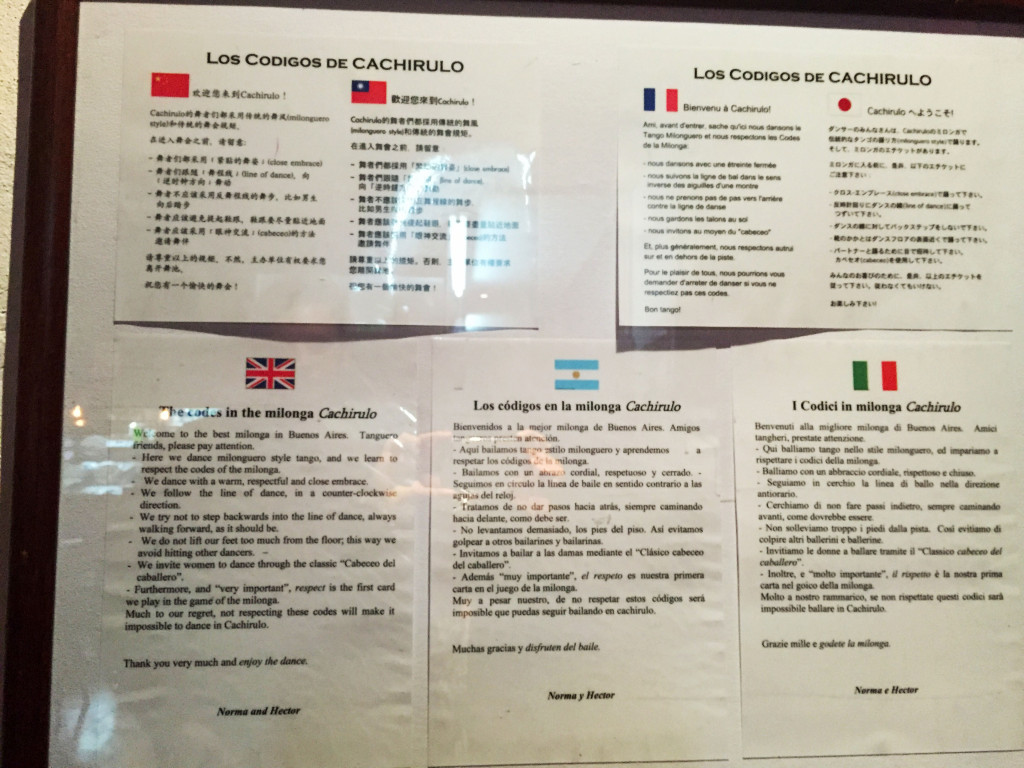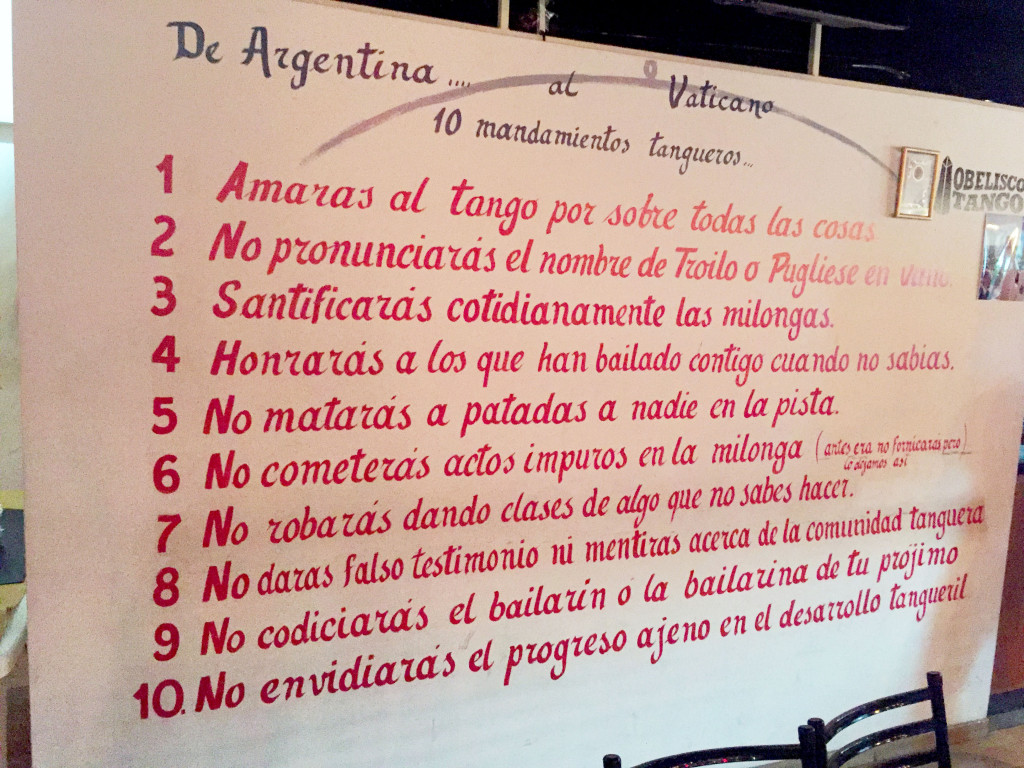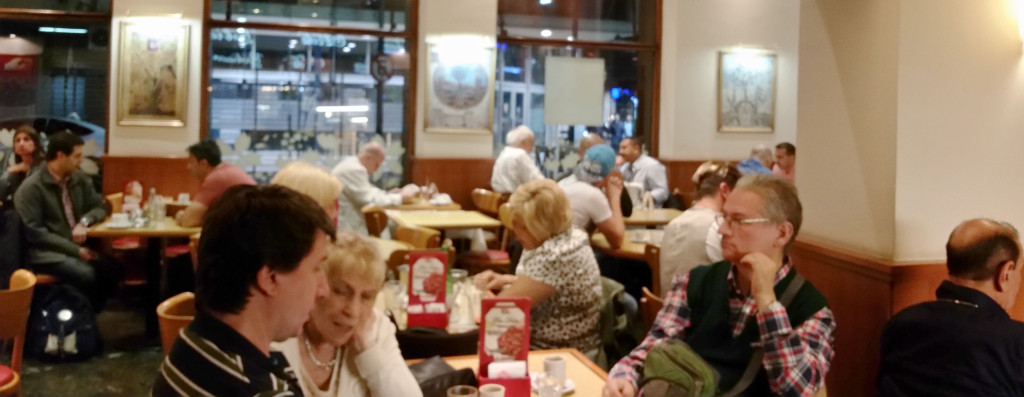Almost every guidebook, website, or blog about Buenos Aires starts by describing it as the birthplace of tango, a place where the people live and breathe tango. So far we’ve seen a couple of street performances of tango (which were pretty great), but I was dying to see Argentine tango in it’s natural habitat.
Thankfully, Narrative Tango Tours had just what I was looking for: a guided experience where a professional tango dancer well-versed in its history took us to a milonga and explained the traditions, nuances, and various “rules” of the dance hall.

We arrived to meet our guide Francisca at 10:30pm outside Obelisco Tango. She led us inside the dance hall, unassuming from the exterior. We were greeted by the milionga organizer, an elder man who gave us each a kiss on the cheek (but knowing we were tourists, he shook Jon’s hand), and seated us close enough to the dance floor to see, but not in the prime seating. It’s very normal for Argentines to greet each other with a kiss on the cheek, whether you are a man or a woman (yes, men give other men a kiss too!).
Men were seated on the left side of the hall and women on the right, facing each other. The areas in between had couples and some of the regulars. In a milonga, the man always must ask the woman to dance, not the other way around. And the way they do it? The nod.

Yep, in order for a man to ask a woman to dance, he catches her eye from across the hall and gives her a nod. If she accepts, she can smile, nod back, or stand up to meet him on the floor. If not, she looks away and her rejection is clear.
There are three styles of tango music, Tango-Milonga, Tango-Tango, or Tango-Waltz. Only music from pre-1940 is played in traditional milonga, so many attendees already know most, if not all the songs. While tango-tango is the most popular style, tango-milonga was the earliest style of tango to form, and developed by Brazil’s ex-slave population, who came down the Río de Plata and settled on both the Uruguayan side and Argentine side. They brought African candombe dance and music, known for it’s recognizable steady drum beat overlayed with improvised drums. Faster footwork and beats are signature to the tango-milonga style. During tango-waltz, pairs tend to rotate more often within the milonga, similar to the waltz. (Click here to see it in action! Or here for another example.)
Milonga DJs play songs in groups of three, and the DJ knows never to vary from the style of music selected for that grouping. In fact, it’s not enough to keep within the same style, the DJ even stays within the same composer! That way, as a dancer you know exactly what you’re getting into before inviting or accepting a dance.
Three tango songs within the same style and artist, and then a non-tango song. During the non-tango song the men and women will part and go back to their seats to await the next pairing and then dance. It’s a faux pas to part with your partner before the 3-song set ends.
Francisca explained there is even a pattern for the sets of tango songs; traditionally it goes a tango-milonga set, two tango-tango sets, a tango-waltz set, and then another two tango-tango sets (then starts over).
A girl from Ohio sat next to us shortly after we arrived. She was alone, and it was her first time here she excitedly explained to us after hearing us speak English. She seemed like she could use a friend, but since we were paying for a private guided tour, we were more than a little engaged with Francisca and her story-telling to give her much attention.
Ohio had a very low-cut red dress with a push-up bra, and her hair was down. Francisca pointed out that she was actively looking for a nod, but lamented that she might not get a dance, being a new attendee seated on the outskirts of the dance floor. She left after an hour or so, without a nod or a dance.
If you are new to a milonga, it can be hard to get that first dance. Regular and elder attendees get better seats (closer to the dance floor and with a clearer line of sight for a nod). Francisca told us that the first time she attended a particular milonga, she was sitting in the fourth row of ladies’ chairs, and hardly got to dance. She attended week after week, slowly moving up to better seats as the host got to know her, and eventually she got to the second row. If it was a slow night, she might even get a spot in the front row (usually reserved for the elder ladies—how respectful!).
 It can also help to look like a dancer, Francisca told us. Ballerina-styled hair in a slicked-back bun and perfect posture can go a long way. Without knowing what kind of dancer you are, guys may be wary of giving you the nod. If an organizer sees a new lady that has been sitting and sitting without a dance, he may ask a guy he’s familiar with to invite her to dance, even if it’s only for the last song in the trio, or the last half-song in the trio, keeping it low-commitment, but giving her a chance to show off what she is capable of. Once you get a dance and others see your skill-level and style, it can be much easier to get a second invitation, and perhaps another and another, a snowball effect, providing you aren’t a rhythmless toe-stomper.
It can also help to look like a dancer, Francisca told us. Ballerina-styled hair in a slicked-back bun and perfect posture can go a long way. Without knowing what kind of dancer you are, guys may be wary of giving you the nod. If an organizer sees a new lady that has been sitting and sitting without a dance, he may ask a guy he’s familiar with to invite her to dance, even if it’s only for the last song in the trio, or the last half-song in the trio, keeping it low-commitment, but giving her a chance to show off what she is capable of. Once you get a dance and others see your skill-level and style, it can be much easier to get a second invitation, and perhaps another and another, a snowball effect, providing you aren’t a rhythmless toe-stomper.
We saw many dancers use fans while seated, both men and women. In the muggy summer days milongas can get VERY hot (and imagine dancing in the humid weather wearing a suit). In fact, it can be common for women to place a napkin between their fingers and the man’s back or a man to place a handkerchief between his and his partner’s hand to help with sweat.
Perhaps one of the more well-known rules of a milonga is the counter-clockwise rotation which keeps order and helps avoid collisions. Oftentimes the best dancers will stick to the outside to show off their stuff and the less-experienced tangueros might stick to the inside of the circle. However sometimes the center can be a more spacious area, allowing experienced dancers room for fancy steps requiring room to move.
Age nor class matters at a milonga. It’s common to see old men dancing with young ladies and young men dancing with old ladies. Though many men dress in full suits, they also wear jeans with button-ups. The women dressed with lots of flair as well. Asymmetrical hems were common on dresses and skirts, and I admired almost every colorfully-printed pair of pants I saw. The only “must” is a pair of shoes with leather soles since rubber soles can cause injury to the joints during spins/turns and ankle straps, so your shoes don’t go flying off during fast footwork.
Once you have been to a milonga enough, or to enough milongas with familiar faces, you may have a repertoire with other dancers. Francisca explained that dancers may have a preference to dance certain styles of tango with certain dancers they know well.

Francisca pointed out a table of elderly men sitting in front of us. Tango is a way of life for many Argentines, and some of these men have been attending the same milongas for years, “they are like the furniture here” she told us, ever-present fixtures of the dance hall. They are extremely knowledgeable in tango dance and culture, and dancing with them can be “like riding in a Ferrari” a symbol of status at the milonga. Another unexpected benefit, she explained, was that sometimes older men are shaky and don’t have as upright posture, making it easier for a beginner learning to dance.
There are a few embraces in tango, and while the man must choose the woman with whom he dances, the woman gets to chose whether the embrace is open or closed. A closed embrace is traditional to Argentine tango, and Francisca described it as having four legs and one torso (a neat description). Beginners commonly use an open embrace to keep from stepping on each others’ feet, but more experienced tangueros may also use it to provide more space for rotations and complex moves.
Tango was originally danced by men with other men, because men and women dancing together was seen as crude, something reserved only for brothels or married couples at family parties. During the dictatorship, milongas were forbidden as curfew meant you would not be out past 10pm anyway. Thankfully that’s no longer the case and people travel from all over the world to join in the tango scene in Buenos Aires where you can find milongas every night of the week.

Francisca left us, but before 2am they paused the dance hall in order to recognize two dancers (honestly I’m not sure what for), but we got to see them perform a lovely dance solo!
Although we left shortly after, the milonga kept going until 4am that day. It’s pretty incredible that people can stay up all night dancing, but Francisca has said that she has heard of friends with office jobs that work from noon until 8pm (no break at all though, they eat while working, she said). Considering we saw people lining up for dinner at restaurants by the milonga just after 10pm, I see why breakfast, lunch, and dinner are so late by US standards!
Here’s a shot of a café we stopped at on the way back to the apartment (past 2am). Not only was it busy, but many of the customers were of an impressive age.

Very nice. I love to see the tangeros in their comfortable place just like you did. It sounds fun learning the tradition and being told why is done the way is done.
Thanks for educating me in some of the argentine milonga
That was a very insightful blog post Sam. I had no idea about the tango culture – how very intriguing! This makes me even more enthusiastic about learning a couples dance. I’m great solo but pretty lousy with a partner. I want to learn one dance decently enough to join at places like this, or perhaps to start with, at parties or dance events. That way I can get better and better and join in on festivities.
Glad you enjoyed! From my experience, couples dances rely largely on the male to lead, so if you can follow rhythms, it’s much easier to pick up =)